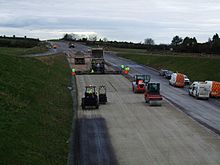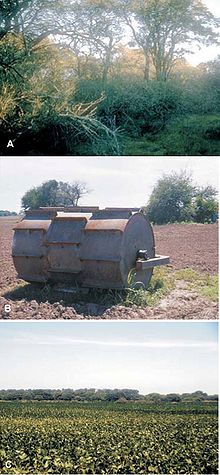Land development
Land development is the alteration of landscape in any number of ways such as:
- Changing natural or semi-natural state for a purpose such as agriculture or housing
- lots, typically for the purpose of building homes
- condominium.
History
Land development has a history dating to Neolithic times around 8,000 B.C. From the dawn of civilization, the process of land development has elaborated the progress of improvements on a piece of land based on codes and regulations, particularly housing complexes.
Economic aspects
In an economic context, land development is also sometimes advertised as land improvement or land amelioration. It refers to
In an
- Road construction
- Access roads, walkways, and parking lots
- Bridges
- Landscaping
- land levelling
- Land preparation (development) for gardens
- Setup of fences and, to a lesser degree, hedges
- Service connections to municipal services and public utilities
- Drainage, canal systems
- External lighting (street lampsetc.)
A
Development analysis puts development prospects and the development process itself under the microscope, identifying where enhancements and improvements can be introduced. These improvements aim to align with best design practice, political sensitivities, and the inevitable social requirements of a project, with the overarching objective of increasing
Development analysis can add significantly to the value of land and development, and as such is a crucial tool for landowners and developers. It is an essential step in
Land value is highly sensitive to supply and demand (for the end product), build costs, planning and affordable housing contributions, and so on. Understanding the intricacies of the development system and the effect of "value drivers" can result in massive differences in the landowner's sale value.
Conversion of landforms
Land development puts more emphasis on the expected
Conversion to building land

Conversion to building land is as a rule associated with

Construction activity often effectively seals off a larger part of the soil from
With the notable exception of attempts at
Conversion to farmland

New creation of
- Hydrological measures (land levelling, drainage, irrigation, sometimes landslide and flood control)
- fertilization, establishment of a productive chemical balance).
- Road construction
Because the newly created farmland is more prone to
The resulting
Restoration
Massive land conversion without proper consideration of
- General soil degradation
- Catastrophic soil salination and solonchak formation, e.g., in Central Asia, as a consequence of irrigation by saline groundwater
- Desertification, soil erosion and ecological shifts due to drainage
- Leaching of saline soils
- Catastrophic
- Habitat lossfor the wildlife.
While deleterious effects can be particularly visible when land is developed for industrial or mining usage, agro-industrial and settlement use can also have a massive and sometimes irreversible
Examples of
Environmental issues
The environmental impact of
In most cases, the land development project will be allowed to proceed if mitigation requirements are met.[citation needed] Mitigation banking is the most prevalent example, and necessitates that the habitat will have to be replaced at a greater rate than it is removed. This increase in total area helps to establish the new ecosystem, though it will require time to reach maturity.[citation needed]
Biodiversity impacts
The extent, and type of land use directly affects
Deforestation is also the reason for loss of a
The
See also
- Agricultural expansion – Growth of agricultural land in the 21st century
- Built-up area– Human settlement with high population density and infrastructure of built environment
- Colonization – Establishment and development of settlements by people or animals
- Manifest destiny – Cultural belief of 19th-century American expansionists
- Developed environments– Community of any size, in which people live
- Developmentalism – Economic theory
- Environmental impact statement – Assessment required under US environmental law
- Illegal construction – Type of construction work
- Infrastructure – Facilities and systems serving society
- Land consumption – expansion of built-up area that can be directly measured in a defined area
- Land development bank – type of bank in India
- Land grabbing – Large-scale acquisition of land (over 1,000 ha) whether by purchase, leases or other means.
- Land management – Process of managing land
- Land reclamation – Creating new land from oceans, seas, riverbeds or lakes
- Land recycling – Reuse of abandoned buildings or sites
- Landscape ecology – Science of relationships between ecological processes in the environment and particular ecosystems
- Land-use conflict – disagreement about what a particular area of land should be used for
- Leopold matrix – Environmental impact assessment method
- Mitigation banking – Wetland improvement to offset development
- Ocean development – Establishing of human activities at sea and use of the ocean
- Political action committee – American political organization
- Real estate development – Process that creates or renovates new or existing spaces
- Subdivision (land) – Divided piece of land
- Subsurface drainage – A system by which water is drained on
- Sustainable agriculture – Farming approach that balances environmental, economic and social factors in the long term
- Urban planning – Technical and political process concerned with the use of land and design of the urban environment
- Urban renewal – Land redevelopment in cities
- Watertable control – Use of drainage to control the groundwater level in an area
References
- ISBN 9780471778936.
- OL 5795447M.
- ^ Top soil is removed from the new road bed (Video). Dayton, TN: Bryan College. 2009-09-03. Archived from the original on 2021-12-12.
- ^ Urban Soil Compaction (PDF) (Report). Soil Quality – Urban Technical Note No. 2. Auburn, AL: U.S. Natural Resources Conservation Service, Soil Quality Instsitute. March 2000.
- ^ Wilson, Sarah Jane (2014-08-14). "Not All Forests Are Created Equal: Reforesting the Tropics for People, Biodiversity, and Carbon". The Equation (Blog). Cambridge, Massachusetts: Union of Concerned Scientists.
- ^ Boucher, Doug (June 2011). The Root of the Problem: What's Driving tropical Deforestation today? (PDF) (Report). Tropical Forest and Climate Initiative. Cambridge, Massachusetts: Union of Concerned Scientists. p. 85.
- ^ "Monocultures". Barcelona, Spain: Carbon Trade Watch. Retrieved 2016-08-28.
- S2CID 40051432.
- ISSN 1266-5304.
- )
- )
- ISBN 0-300-08483-8.
- ^ C. Michael Hogan. 2009. Painted Hunting Dog: Lycaon pictus, GlobalTwitcher.com, ed. N. Stromberg Archived 2010-12-09 at the Wayback Machine
- ^ Ehrhardt-Martinez, Karen (Aug 16, 2003). "Demographics, Democracy, Development, Disparity and Deforestation: A Crossnational Assessment of the Social Causes of Deforestation". American Sociological Association. Archived from the original on 2008-12-10.
- ^ Lund, H. Gyde (2006). Definitions of Forest, Deforestation, Afforestation, and Reforestation. Gainesville, VA: Forest Information Services.
- ^ "Forest Service report forecasts natural resource management trends and challenges for next 50 years | US Forest Service". www.fs.usda.gov. 17 April 2013. Retrieved 2020-04-22.
- ^ National Conference of State Legislature."State Forest Carbon Incentives and Policies".Jocelyn Durkay and Jennifer Schultz..22 March 2016. Web.25 April 2015.http://www.ncsl.org/research/environment-and-natural-resources/state-forest-carbon-incentives-and-policies.aspx
- R.J. Oosterbaan, International Institute for Land Reclamation and Improvement, Wageningen, The Netherlands. "Improvement of waterlogged and saline soils." Free downloads of software and articles on land drainage.
- Kone, D. Linda (2006). Land Development (10th ed.). Washington, D.C.: National Association of Home Builders. ISBN 9780867186093.
- Dewberry & Davis (2008). Land Development Handbook (3rd ed.). New York: McGraw-Hill Professional. ISBN 9780071640930.
- Colley, Barbara C. (2005). Practical Manual of Land Development (4th ed.). McGraw-Hill. ISBN 0071448667.
